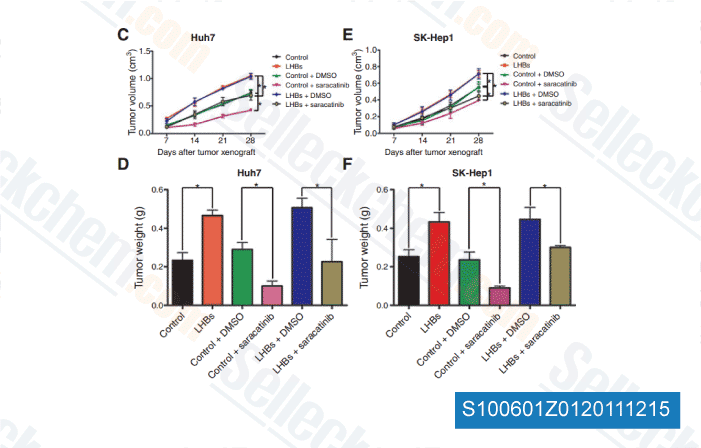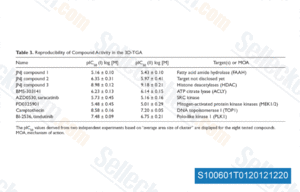|
Toll Free: (877) 796-6397 -- USA and Canada only -- |
Fax: +1-832-582-8590 Orders: +1-832-582-8158 |
Tech Support: +1-832-582-8158 Ext:3 Please provide your Order Number in the email. |
Technical Data
| Formula | C27H32ClN5O5 |
|||
| Molecular Weight | 542.03 | CAS No. | 379231-04-6 | |
| Solubility (25°C)* | In vitro | DMSO | 100 mg/mL (184.49 mM) | |
| Ethanol | 100 mg/mL (184.49 mM) | |||
| Water | Insoluble | |||
|
* <1 mg/ml means slightly soluble or insoluble. * Please note that Selleck tests the solubility of all compounds in-house, and the actual solubility may differ slightly from published values. This is normal and is due to slight batch-to-batch variations. * Room temperature shipping (Stability testing shows this product can be shipped without any cooling measures.) |
||||
Preparing Stock Solutions
Biological Activity
| Description | Saracatinib (AZD0530) is a potent Src inhibitor with IC50 of 2.7 nM in cell-free assays, and potent to c-Yes, Fyn, Lyn, Blk, Fgr and Lck; less active for Abl and EGFR (L858R and L861Q). Saracatinib induces autophagy. Phase 2/3. | |||||||||||
|---|---|---|---|---|---|---|---|---|---|---|---|---|
| Targets |
|
|||||||||||
| In vitro | Saracatinib also potently inhibits other Src tyrosine kinase family members including c-Yes, Fyn, Lyn, Blk, Fgr, and Lck with IC50 from 4-10 nM. Saracatinib sensitively inhibits Src Y530F NIH 3T3 with IC50 of 80 nM. Saracatinib significantly impairs the invasion of HT1080 cells through a 3-dimensional collagen matrix and completely inhibits EGF-induced cell scattering in NBT-II bladder cancer cells. [1] Saracatinib potent inhibits Src activation in DU145 and PC3 cells, which through inhibition of Y419 phosphorylation. Saracatinib inhibits the growth of prostate cancer including PC3, DU145, CWR22Rv1 and LNCaP, while Saracatinib shows low activity in LAPC-4, PZ-HPV7 and RWPE-1 cells. Saracatinib induces cell cycle arrest at G1/S but not caspase 3 cleavages. Saracatinib also significantly inhibits DU145 and PC3 migration in the Boyden chamber. [2] Saracatinib gives a potent and sustained blockage of AKT and enhances the sensitivity to irradiation in A549 and Calu-6 cells. [3] Saracatinib inhibits osteoclast in activity, resorption and formation. Saracatinib also reversibly prevents osteoclast precursor migration. [4] |
|||||||||||
| In vivo | Saracatinib shows great tumor growth inhibition in Src3T3 allografts and a moderate growth delay in Calu-6, MDA-MB-231, AsPc-1 and BT474C xenografts. [1] Saracatinib shows great antitumor activity in orthotopic DU145 xenograft mice at a dose of 25mg/kg (orally administered, daily). [2] |
|||||||||||
| Features | The 1st Src inhibitor to show inhibition of the Src pathway in human tumor tissue. |
Protocol (from reference)
| Kinase Assay: |
|
|---|---|
| Cell Assay: |
|
| Animal Study: |
|
References
Customer Product Validation

-
Data from [Cancer Res, 2013, 71, 7547-57]

-
Data from [J Biomol Screen, 2013, 18, 54-66]

-
Data from [J Biomol Screen, 2013, 18, 54-66]

-
Data from [Cancer Res, 2012, 71, 7547-57]
Selleck's Saracatinib (AZD0530) has been cited by 343 publications
| Heterogeneity-driven phenotypic plasticity and treatment response in branched-organoid models of pancreatic ductal adenocarcinoma [ Nat Biomed Eng, 2024, 10.1038/s41551-024-01273-9] | PubMed: 39658630 |
| The pro-oncogenic noncanonical activity of a RAS•GTP:RanGAP1 complex facilitates nuclear protein export [ Nat Cancer, 2024, ] | PubMed: 39528835 |
| Kisspeptin-10 binding to Gpr54 in osteoclasts prevents bone loss by activating Dusp18-mediated dephosphorylation of Src [ Nat Commun, 2024, 15(1):1300] | PubMed: 38346942 |
| The proto-oncogene tyrosine kinase c-SRC facilitates glioblastoma progression by remodeling fatty acid synthesis [ Nat Commun, 2024, 15(1):7455] | PubMed: 39198451 |
| Viral infection induces inflammatory signals that coordinate YAP regulation of dysplastic cells in lung alveoli [ J Clin Invest, 2024, 134(19)e176828] | PubMed: 39352385 |
| The SRC-family serves as a therapeutic target in triple negative breast cancer with acquired resistance to chemotherapy [ Br J Cancer, 2024, 131(10):1656-1667] | PubMed: 39390250 |
| FGF receptor kinase inhibitors exhibit broad antiviral activity by targeting Src family kinases [ Cell Mol Life Sci, 2024, 81(1):471] | PubMed: 39621133 |
| RAPSYN-mediated neddylation of BCR-ABL alternatively determines the fate of Philadelphia chromosome-positive leukemia [ Elife, 2024, 12RP88375] | PubMed: 38865175 |
| Gender-different effect of Src family kinases antagonism on photophobia and trigeminal ganglion activity [ J Headache Pain, 2024, 25(1):175] | PubMed: 39390364 |
| Merkel cell polyomavirus protein ALTO modulates TBK1 activity to support persistent infection [ PLoS Pathog, 2024, 20(7):e1012170] | PubMed: 39074144 |
RETURN POLICY
Selleck Chemical’s Unconditional Return Policy ensures a smooth online shopping experience for our customers. If you are in any way unsatisfied with your purchase, you may return any item(s) within 7 days of receiving it. In the event of product quality issues, either protocol related or product related problems, you may return any item(s) within 365 days from the original purchase date. Please follow the instructions below when returning products.
SHIPPING AND STORAGE
Selleck products are transported at room temperature. If you receive the product at room temperature, please rest assured, the Selleck Quality Inspection Department has conducted experiments to verify that the normal temperature placement of one month will not affect the biological activity of powder products. After collecting, please store the product according to the requirements described in the datasheet. Most Selleck products are stable under the recommended conditions.
NOT FOR HUMAN, VETERINARY DIAGNOSTIC OR THERAPEUTIC USE.
